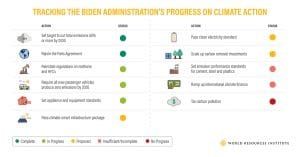The next few years will determine our collective climate future. Here’s how Biden is measuring up.
By Dan Lashof | June 11, 2021
 President Joe Biden drives the new electric Ford F-150 Lightning truck at the Ford factory development center in Dearborn, Michigan on May 18, 2021. (Photo by Nicholas Kamm/AFP via Getty Images)
President Joe Biden drives the new electric Ford F-150 Lightning truck at the Ford factory development center in Dearborn, Michigan on May 18, 2021. (Photo by Nicholas Kamm/AFP via Getty Images)
It’s now been over 100 days since President Joe Biden took office, during which time the United States has done an about-face on climate policy compared with the previous administration. In fact, Biden is attempting to do more to boost climate action in his first few months in office than any previous American president has done during his entire time in office. The question is, given the immense scale of the climate change emergency, is it enough to get the country—and the world—on track to where we need to be?
Of course, it took more than 100 years for climate change to reach its current state of crisis and President Biden can’t be expected to solve it in 100 days. Here’s the status of some of the administration’s biggest climate change actions so far—and what remains to be done.
Completed: rejoining Paris Agreement, setting 2030 emissions-reduction target. On his first day in office, Biden initiated America’s return to the Paris Agreement—a move promised in his campaign platform and eagerly awaited by many countries. This was an important step toward restoring trust in the agreement and the power of international climate diplomacy; however, simply rejoining the agreement is not enough. To bring the agreement’s goal of limiting global warming to 1.5 degrees Celsius within reach, countries must rapidly curb emissions and put the world on track to reach net-zero by 2050.
On Earth Day, the Biden-Harris administration took a crucial step in this direction, announcing a new goal to cut US emissions at least in half from 2005 levels by 2030. This commitment almost doubles the previous US pledge to cut emissions 26-to-28 percent by 2025. It will also create millions of good jobs, reduce death and disease from air pollution, and make the US economy more competitive internationally.
Works in progress: super pollutants, clean cars, efficiency standards. Understanding that taking ambitious climate action requires a whole-of-economy approach, the Biden-Harris administration is currently working on a range of specific policies that will help make this 2030 goal possible. For example, the US Environmental Protection Agency has proposed a regulation to begin phasing down hydrofluorocarbons, and the Senate has voted to reinstate methane emissions standards; both are highly potent so-called “super-pollutants” that pound-for-pound are more damaging to the climate than carbon dioxide. The Biden administration is also moving to reinstate strong emissions standards for passenger vehicles and electrify the government’s vehicle fleet—key steps toward ensuring that by 2035 all new passenger vehicles sold in the United States will produce zero emissions. Meanwhile, the US Energy Department is setting new appliance and equipment standards that will improve energy efficiency and reduce long-term costs.
Proposed: American Jobs Plan. In late March Biden announced the American Jobs Plan, a $2-trillion proposal that seeks to create millions of much-needed jobs as the economy struggles to recover from the COVID-19 pandemic while laying the groundwork for a zero-emissions future. This is the centerpiece of Biden’s climate plan and a good financial decision, as research has found that investing in clean energy can create two to three times the number of jobs as investing the same amount in fossil fuels. The plan includes everything from improving energy efficiency in affordable housing to building electric vehicle charging stations to expanding public transit options to plugging old oil and gas wells and restoring forests, wetlands, and other ecosystems that help remove carbon from the atmosphere and boost resilience to extreme weather.

The American Jobs Plan also includes proposals to scale up investment in carbon sequestration efforts—which will capture carbon dioxide directly from emission sources (and from ambient air) and could create at least 61,000 American jobs through 2035. To accelerate carbon capture and permanent carbon dioxide storage, the plan aims to reform and expand a largely unheralded bipartisan tax credit known as 45Q, a sort of inverse carbon tax which allows companies to earn money per ton of carbon dioxide captured and sequestered; the proposed revisions to this credit would allow participants to receive a direct payment (instead of a credit on their tax returns), making it easier to use for hard-to-decarbonize industrial applications, direct air capture, and retrofits of power plants.
The Biden administration has also recommended an energy efficiency and clean electricity standard that would require utilities to employ growing percentages of wind, solar, and other carbon-free power sources to reach an 80 percent reduction in power plant emissions by 2030, and 100 percent clean electricity by 2035. Enacting such a standard would help turn these climate aspirations into mandates that are more likely to outlast Biden’s term in office; however, it’s unclear whether there will be enough support in Congress to pass such legislation.
House Speaker Nancy Pelosi has promised action on the American Jobs Plan in the House of Representatives by July 4, but Congress is unlikely to complete its work on the package until the fall.
Insufficient: emissions standards for material production, ramping up international climate finance. Creating emissions standards are crucial to curb the massive climate impact of some of our most-used materials. Cement and steel are some of the most fossil fuel-intensive materials to produce, representing 8 percent and 7 percent of global carbon dioxide emissions, respectively. Meanwhile, petroleum-based plastics are clogging our ecosystems, choking wildlife and taking a dangerous toll on human health. While Biden’s January executive order on procurement calls on the government to use its purchasing power to create demand for “necessary products and materials” to achieve decarbonization, and the American Jobs Plan calls for investment in projects to demonstrate the production of low-carbon cement and steel, the administration has not taken any steps toward establishing emissions standards covering energy-intensive industries.
In addition, the administration has not stepped up sufficiently on increasing international climate finance to help developing countries take the actions required to reduce emissions and adapt to climate impacts. Biden has pledged $5.7 billion a year in international finance to address climate change—a major increase but still far short of what is required to meet the urgent needs of vulnerable countries and position the United States as a leader among developed country donors. For example, the $1.2 billion Biden requested for the Green Climate Fund does not even fully deliver on the $2 billion pledge made by the Obama-Biden administration, let alone match the level of effort that other developed countries have shown by doubling their commitments.
No progress: tax carbon pollution. Pricing or taxing carbon pollution would help lower emissions quickly in the power sector and, if applied economy-wide, help decarbonize the most challenging-to-decarbonize sectors, such as industry. There are multiple carbon tax proposals in Congress and there is also increasing support for the concept from the private sector; however, the politics of taxing carbon pollution remains fraught, and Biden has not pushed the idea.
Biden is well-versed in the immense benefits that taking climate action will bring to Americans, frequently saying “When I think of the climate crisis, I think of jobs.” If backed by legislation passed by Congress, greater US climate action would likely prompt stronger climate commitments from other major emitters, including China. The world is at a crucial juncture where the actions we take over the next few years will determine what our collective future looks like. This is especially true for high-emitting countries like the United States. The sooner Congress gets on board, the sooner we can start to reap those benefits.
Together, we make the world safer.
The Bulletin elevates expert voices above the noise. But as an independent nonprofit organization, our operations depend on the support of readers like you. Help us continue to deliver quality journalism that holds leaders accountable. Your support of our work at any level is important. In return, we promise our coverage will be understandable, influential, vigilant, solution-oriented, and fair-minded. Together we can make a difference.















